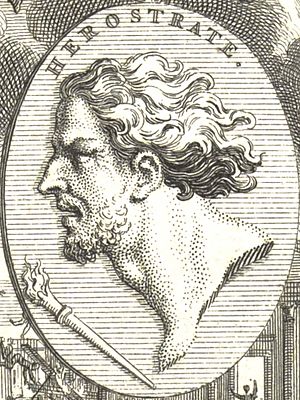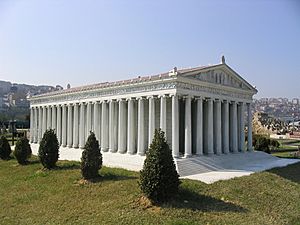Herostratus facts for kids
Quick facts for kids
Herostratus
|
|
|---|---|
| Ἡρόστρατος | |
 |
|
| Born | |
| Died | c. 356 BC Ephesus
|
| Cause of death | Execution |
| Nationality | Ephesian |
| Known for | Destroying the Temple of Artemis at Ephesus—and, concomitantly, seeking fame at any cost |
Herostratus (Ancient Greek: Ἡρόστρατος) was an ancient Greek man who lived around 356 BC. He became famous for a terrible reason: he burned down the magnificent Temple of Artemis in Ephesus. This temple was one of the Seven Wonders of the Ancient World. Herostratus admitted he did it just to make his name remembered forever.
To stop others from doing similar things, the people of Ephesus made a special law. It said no one was allowed to say or write Herostratus's name. If you did, you could be put to death! But this law didn't work. His name was still written down by historians, and we know about him today. Because of this, Herostratus's name is now used to describe someone who does something bad just to become famous.
Contents
Herostratus's Story
The Temple of Artemis in Ephesus was a very old and sacred place. People had used the site for religious purposes since the Bronze Age. The first temple there was destroyed by a flood in the 7th century BC.
The Temple of Artemis
A second, even grander temple was built around 560 BC. King Croesus of Lydia ordered its construction. Architects from Crete, like Chersiphron, helped design it. This temple was mostly made of marble. It was huge, about 337 feet long and 180 feet wide. Its tall pillars stood 40 feet high. The bases of these pillars had detailed carvings of people. The roof was open to the sky around a statue of the goddess Artemis. This second temple was considered one of the Seven Wonders of the Ancient World.
The Crime and Punishment
We don't know much about Herostratus himself. Some historians believe he might have been a person of low social standing or perhaps even a slave. The fire that destroyed the second temple happened on a very famous day: July 21, 356 BC. This was the same day that Alexander the Great was born!
After the fire, Herostratus was caught. He was questioned severely and confessed to starting the fire. He said he did it to make his name live on forever. The people of Ephesus were very angry. To discourage anyone else from seeking fame in such a destructive way, they put Herostratus to death. They also tried to make sure his name would be forgotten forever. They passed a law that made it a crime, punishable by death, to even mention his name.
However, an ancient historian named Theopompus, who was not from Ephesus, wrote about Herostratus. Later, another historian named Strabo also mentioned him. This is how Herostratus's name survived, despite the strict law.
Work on a third temple began in 323 BC. This one was even bigger and more beautiful. It also became known as one of the Seven Wonders of the Ancient World.
Why We Remember Him
Herostratus's name has continued to be used in stories and books. Today, "Herostratic fame" means wanting to be famous at any cost, even if it means doing something terrible. He is an example of someone who tried to force his way into history. He wanted to be remembered, no matter what.
Herostratus in Culture
- The English writer Geoffrey Chaucer mentioned Herostratus in his work The House of Fame.
- Many Spanish authors in the 16th and 17th centuries used Herostratus as an example of someone seeking fame at any cost. He is mentioned in Miguel de Cervantes' famous book Don Quixote.
- The French writer Jean-Paul Sartre wrote a short story called "Erostratus" in 1939, which was directly inspired by Herostratus's story.
- In the 2018 film Assassination Nation, a hacker uses the name "Er0str4tus" to leak private information, causing chaos.
See also
 In Spanish: Eróstrato para niños
In Spanish: Eróstrato para niños
- Famous for being famous
- Streisand effect


